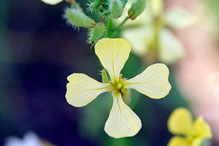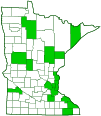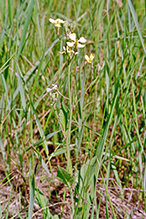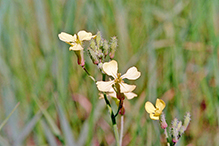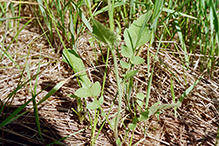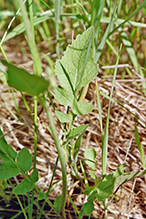wild radish
(Raphanus raphanistrum)
Conservation • Weed • Description • Habitat • Ecology • Use • Distribution • Taxonomy
Conservation Status |
|
|||||||
| IUCN Red List | not listed |
|||||||
| NatureServe | NNA - Not applicable SNA - Not applicable |
|||||||
| Minnesota | not listed |
|||||||
Weed Status |
||||||||
Restricted Weed Seed |
||||||||
Description |
||
Wild radish is a 12″ to 24″ tall, erect, annual forb rising from a small, thick taproot. Initially, there is a rosette of basal leaves. Later, a stem is produced. The stems are branched in the upper portion and usually covered with firm, stiff hairs. The basal leaves are up to 8″ long and 2″ wide. They are oblong, two to four times longer than wide, to inversely egg-shaped, attached to the leaf stalk at the narrow end. They are divided into 5 to 15 oblong lobes with the lower lobes very small, the upper getting progressively larger, the largest lobe at the end. The upper leaves are alternate, smaller, often unlobed, and attached to the stem on short leaf stalks. All leaves are covered with short, stiff hairs. The inflorescence is a cluster of stalked flowers at the end of each stem and branch. The flower is ½″ to ¾″ in diameter on ¼″ to ¾″ long flower stalks. The petals are 4-parted, yellow, and prominently veined, eventually turning to white. They narrow abruptly near the base to a long claw. The flower stalks become erect when the flower matures. The flower is replaced by a single, a 1-celled, seed pod, ¾″ to 1¼″ long with a ⅜″ to 1″ long beak-like tip. It stands erect on the already erect flower stalk. It has two segments. The lower segment is short and does not bear seeds. The upper segment contains 4 to 10 seeds in a single row. It is thick and cylindrical when fresh, prominently ribbed and dented between the seeds when dry. To disperse its seeds it breaks into fragments between the 1-seeded segments. |
||
Height |
||
12″ to 24″ |
||
Flower Color |
||
Yellow, turning to white |
||
Similar Species |
||
Garden radish (Raphanus sativus) has pink or light purple flowers and a thicker taproot. The seed pods have 2 or 3 seeds. |
||
Habitat |
||
Fields, roadsides, disturbed areas. |
||
Ecology |
||
Flowering |
||
June to August |
||
Defense Mechanisms |
||
This and other mustards (family Brassicaceae) produce chemical compounds when cells are damaged that are toxic to most animals, fungi, and bacteria. |
||
Pests and Diseases |
||
|
||
Use |
||
|
||
Distribution |
||||
|
Sources |
|||
| 7/21/2023 | ||||
Nativity |
||||
Native to northern Africa, western Asia, Europe, and Macaronesia. Introduced and naturalized in North America. |
||||
Occurrence |
||||
Uncommon in Minnesota |
||||
Taxonomy |
|||
| Kingdom | Plantae (Plants) | ||
| Division | Tracheophyta (Vascular Plants) | ||
| Subdivision | Spermatophytina (Seed Plants) | ||
| Class | Magnoliopsida (Dicots) | ||
Order |
Brassicales (mustards, capers, and allies) | ||
Family |
Brassicaceae (mustard) | ||
| Subfamily | Brassicoideae | ||
| Supertribe | Brassicodae | ||
| Tribe | Brassiceae | ||
Genus |
Raphanus (radishes) | ||
Subordinate Taxa |
|||
|
|||
Synonyms |
|||
Crucifera raphanistrum Raphanistrum raphanistrum Raphanus raphanistrum f. carneus Raphanus raphanistrum var. purpurascens Rapistrum raphanistrum Sinapis raphanistrum |
|||
Common Names |
|||
jointed charlock white charlock wild radish |
|||
Glossary
Beak
A comparatively short and stout, narrow or prolonged tip on a thickened organ, as on some fruits and seeds.
Claw
A stalk-like narrowed base of some petals and sepals.

Visitor Videos |
|||
Share your video of this plant. |
|||
| This button not working for you? Simply email us at info@MinnesotaSeasons.com. Attach a video, a YouTube link, or a cloud storage link. |
|||
Other Videos |
|||
| The Wild Radish Song AgExcellence |
|||
About
Published on Dec 12, 2013 A parody of the Gotye hit "Somebody I used to know" by agronomic consultant Bill Long, who farms on the Yorke Peninsula of South Australia as well as consults to a number of farmers in the region. This is a farmer's lament on attempts to control wild radish resulting in the loss of chemical options to the point where only radical options are available. Truly reflects the consequences of farming systems becoming reliant on herbicides for weed control. |
|||
| EatTheWeeds: Episode 111: Wild Radish EatTheWeeds |
|||
About
Uploaded on Feb 8, 2010 http://www.eattheweeds.com/radish-mustard%E2%80%99s-wild-rough-cousin/ Can you tell the difference between wild mustards and wild radishes? In this video we look at a wild radish and talk about the differences between these two closely related plants. |
|||
| Wild Radish, Wilderness Survival Martin Survival |
|||
About
Published on Mar 26, 2013 Martin Survival finds wild radish. Every part of wild radish is completely edible; the flowers, leaves, stock, and my favorite part- the root. If you enjoy this video hit the THUMBS UP BUTTON and SUBSCRIBE to Martin Survival on Youtube. Also, visit our website at: FACEBOOK: www.facebook.com/jeffmartinsurvival TWITTER: Martin_Survival INSTAGRAM: Martin Survival Intro and exit Music by Dream Theater : On The Backs Of Angels |
|||
| wild radish Link Knight |
|||
About
Published on Oct 2, 2013 apparently this can cross polinate with charlock mustard/european wild mustard and give you yet another kind of plant. |
|||

Visitor Sightings |
|||||
Report a sighting of this plant. |
|||||
| This button not working for you? Simply email us at info@MinnesotaSeasons.com. Be sure to include a location. |
|||||
|
|||||
MinnesotaSeasons.com Sightings |
|||||

|
Created: Last Updated: © MinnesotaSeasons.com. All rights reserved. |
